
Samsung and Apple are the Yankees and Red Sox of the smartphone world, bitter rivals that ostensibly do the same thing (make great phones) but with slightly different flavors (Android and iOS). And just like fans of Coke and Pepsi, Samsung and Apple fans hate the other’s favorite products.
What better way to foment the endless pool of nerd rage between fans of Apple and Samsung smartphones than to compare their latest and greatest smartphones with each other? Yes, it’s time to pit Samsung’s new Galaxy S6 and Galaxy S6 Edge directly against Apple’s incredibly popular iPhone 6.
How do these smartphones stack up against each other? Let’s go to the ring.
Design
Samsung’s previous flagship smartphones were known for their cheap-feeling plastic bodies, while Apple’s iPhone was known for its premium design. But with the Galaxy S6 the company has finally matched the iPhone’s sleek looks and build quality.
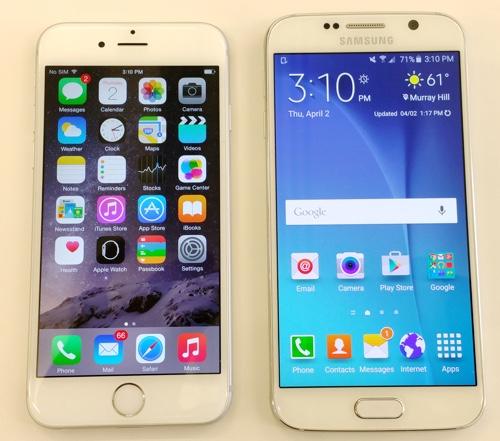
That’s mostly because, with its aluminum frame and glass-covered front and rear panels, the S6 bears a striking resemblance to the iPhone 6. Even after a week with the phones, I still have trouble telling them apart when quickly glancing at them on my desk.
And then there’s Samsung’s Galaxy S6 Edge, which looks like a smartphone from the distant future. Sure, it has the same glass-coated front and back panels and aluminum frame as the standard S6, but with its curved display that cascades off its left and right sides, the Edge manages to make the flat-screen iPhone (and by extension the standard S6) look like the smartphone of yesteryear.
It’s too bad that the S6 Edge’s curved screen, which adds $100 to the price of the standard S6, doesn’t add much to the phone beyond looking awesome.
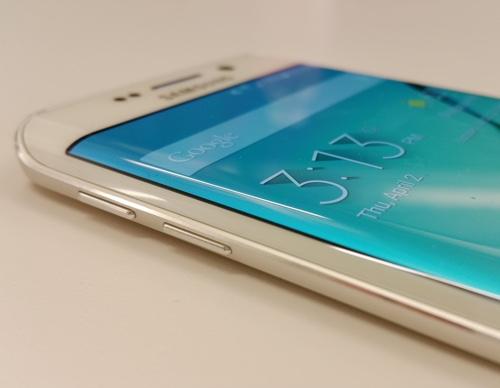
In terms of size, the iPhone 6, with its 4.7-inch display, is both smaller and lighter than the Galaxy S6 and S6 Edge, which both sport the same 5.1-inch display. But the differences are so slight they are hardly noticeable. The S6 Edge’s thin sides do, however, make it a bit uncomfortable to hold for a long time, unlike the standard S6 and iPhone 6, which offer rounded edges.
Display quality
Despite its curved sides, the Galaxy S6 Edge essentially has the same screen as the standard S6. Both sport 2560x1440 resolutions, meaning they’re exceedingly, almost unnecessarily, sharp.
The iPhone 6, on the other hand, rocks a 1334x750 resolution Retina HD display that’s easily one of the best screens Apple has ever made. When it comes to sharpness and clarity, both displays are on par with each other. It’s hard to see any major differences between the two.

You will, however, see a difference in terms of color quality. That’s because the S6 and S6 Edge use Super AMOLED (Active Matrix of Organic Light-Emitting Diode) displays, while the iPhone 6 uses an LCD panel. AMOLED screens are known for their super vibrant colors, and that fact holds true with both the S6 and S6 Edge.
Both the S6’s and iPhone 6’s screens look fantastic, but the colors on the S6 just look more lively. Colors on the iPhone 6 feel less overbearing and a bit cooler. With both screens looking incredibly sharp, the color difference comes down to personal preference.
Camera
This is where things get really interesting. For years, Samsung’s Galaxy S line of smartphones has trailed behind Apple in a key department: camera quality. But that changes with the Galaxy S6 and S6 Edge.
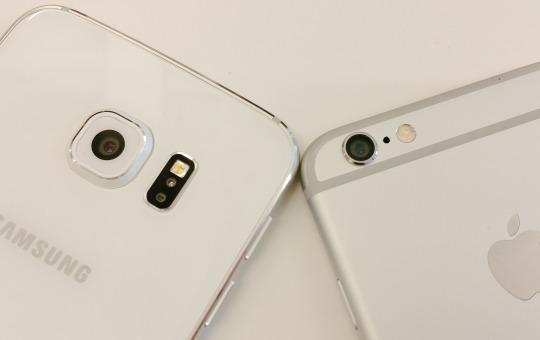
Both phones come with a new 16-megapixel camera, with a wider aperture to improve low-light photos, and improved white balancing. And with optical image stabilization (OIS) the S6’s lens actually moves to help compensate for camera shake. The iPhone 6 uses digital image stabilization, which isn’t as effective as OIS. The iPhone 6 Plus, on the other hand, gets OIS.
The result is a smartphone camera that takes incredibly sharp, colorful photos that look absolutely stunning. Even low-light photos, which Samsung’s phones have struggled with for some time, look amazing on the S6.

The iPhone 6’s eight-megapixel iSight camera was equally impressive, capturing detailed images, with clear, though slightly muted, colors. Both handsets offered beautiful images, but when it comes down to it, the S6’s camera squeaks by the iPhone’s. Eat your heart out, Apple fans.
Special features
Samsung’s smartphones are known for having an abundance of special features, and that’s no different with the S6 and S6 Edge. Both handsets come with an improved fingerprint reader. It’s as good as the iPhone 6’s excellent TouchID reader, but just a tick slower.
The S6 and S6 Edge also come with built-in wireless charging capabilities, which means you can simply rest your phone on a wireless charging pad and the handset will start pulling in power without having to be plugged in. To do the same thing with your iPhone 6, you’ll have to buy a separate wireless charging case.
Samsung has also introduced a new mobile payment system called Samsung Pay, which rivals Apple’s own Apple Pay service.
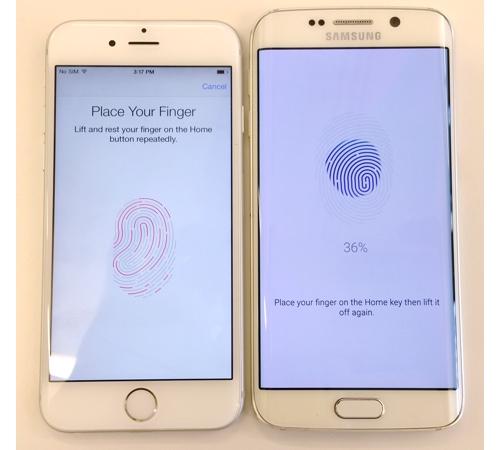
Both systems use NFC (near-field communication) to let you pay for items at stores’ compatible checkout terminals with a quick tap of your phone. Like Apple Pay, Samsung Pay works with NFC terminals, but goes the extra step of working with the same standard magnetic-strip terminals that you swipe your credit card through. That means that when Samsung Pay launches this summer, it will instantly be usable in more locations than Apple Pay.
The problem for Samsung is that U.S. carriers haven’t announced whether they will include Samsung Pay on their versions of the S6 or if customers will have to download the app separately. Conversely, Apple Pay comes preinstalled on the iPhone 6, because Apple has more control over what it puts on its phones.
Interface
The Galaxy S6 and S6 Edge run on Google’s Android 5.0 Lollipop operating system. On top of that Samsung runs its TouchWiz skin, which augments Android to make it look and feel more like a Samsung device.
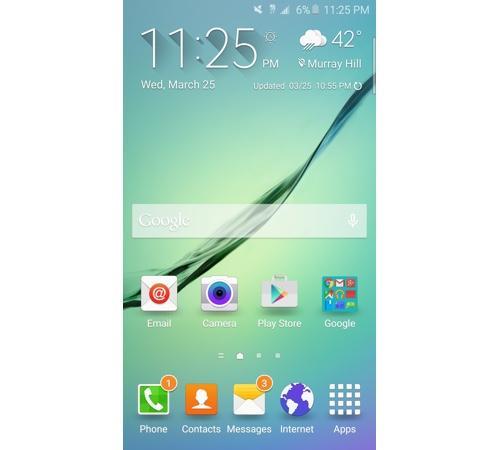
Previous iterations of TouchWiz were largely criticized for being too overbearing and confusing due to the huge number of menus and options the interface included. This time, though, Samsung has scaled back TouchWiz, cutting down on the ridiculous number of settings the interface throws at you, and making it a bit easier to understand.
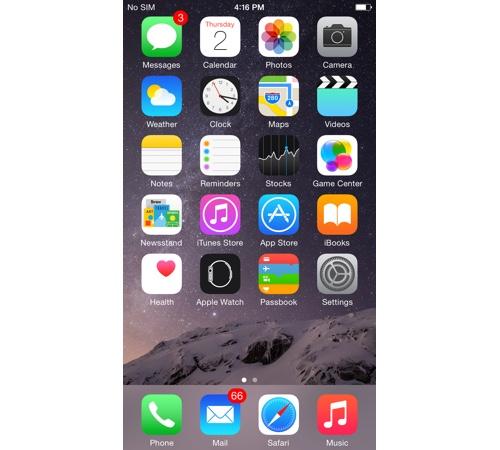
Still, TouchWiz is nowhere near as approachable as Apple’s iOS 8, which is about as straightforward as an interface can get. We’re still holding out hope that Samsung will one day simply sell a Galaxy phone with an unaltered version of Android, but the chances of that happening are slim. The current TouchWiz is, at least, less bad than previous versions.
Outlook
The S6 and S6 Edge are the best smartphones Samsung has ever made. Of the two, the S6 Edge is easily the more impressive, thanks to its beautiful curved display.
When it comes to the S6 versus the iPhone 6, it’s a close contest, but we’re going to have to declare the S6 the better phone, thanks to its brighter, more vibrant display, exceptional camera, improved design, and more flexible mobile payment system. The iPhone 6 does win when it comes to interface design, but that’s just not enough to topple the S6.

No comments:
Post a Comment